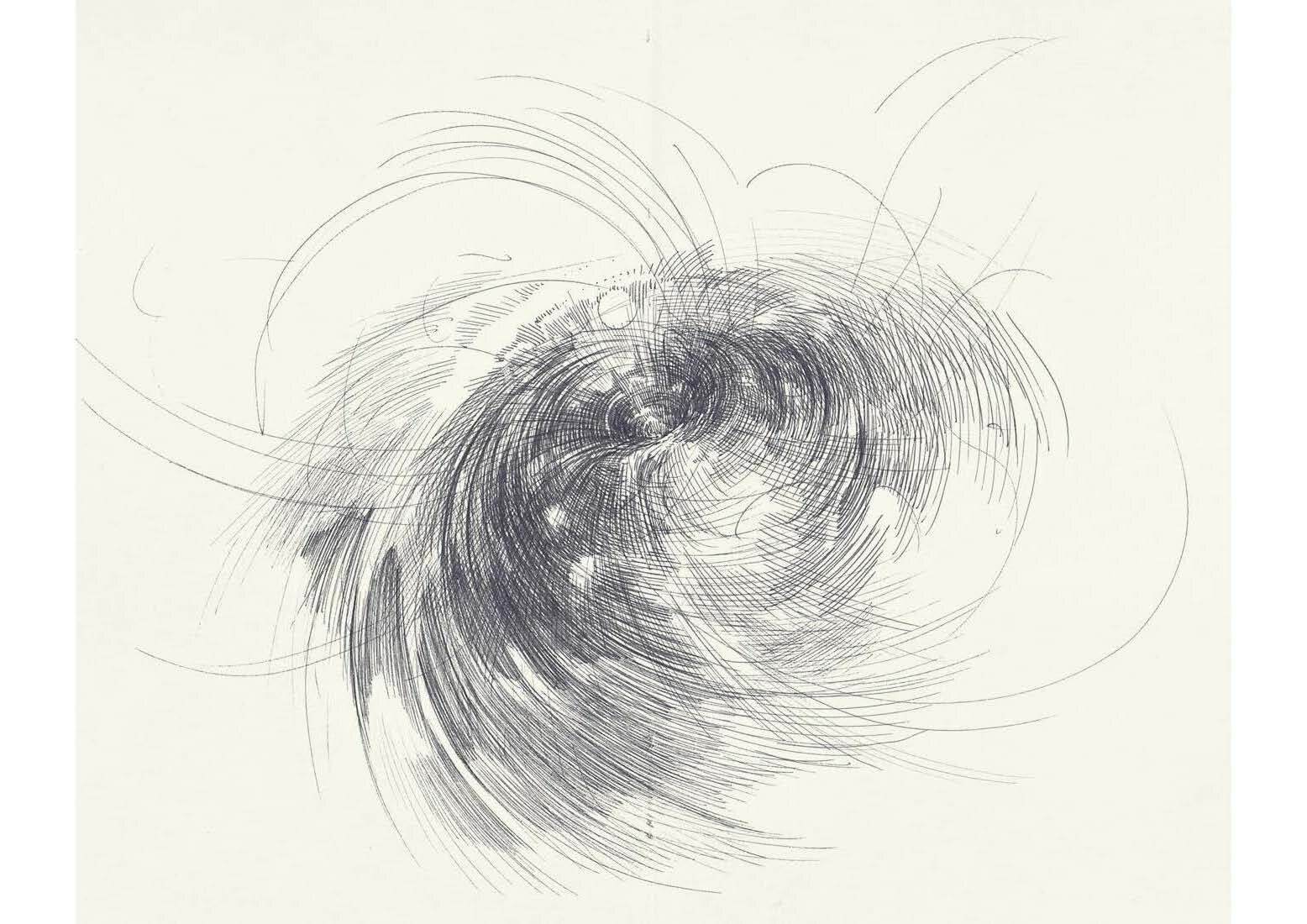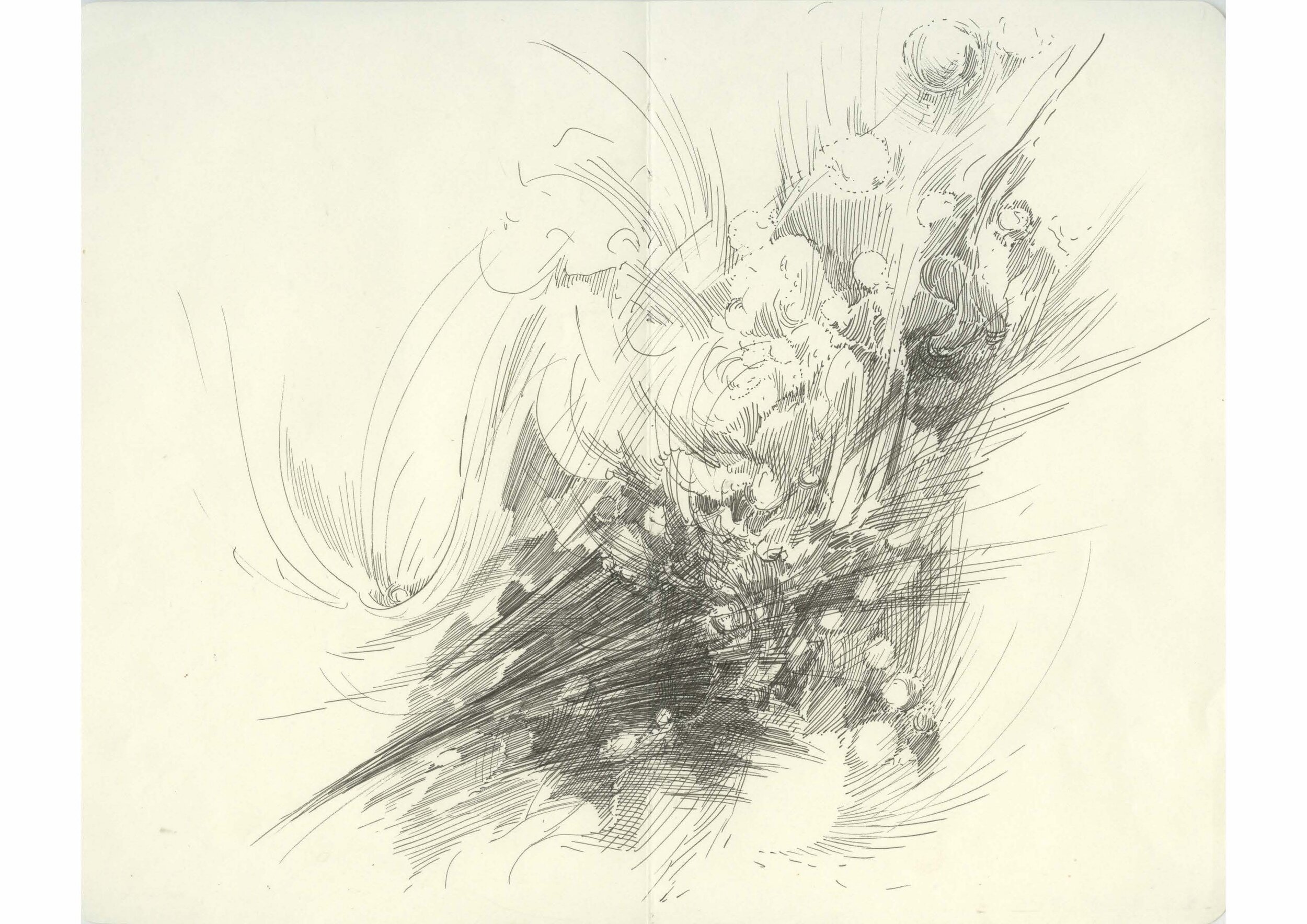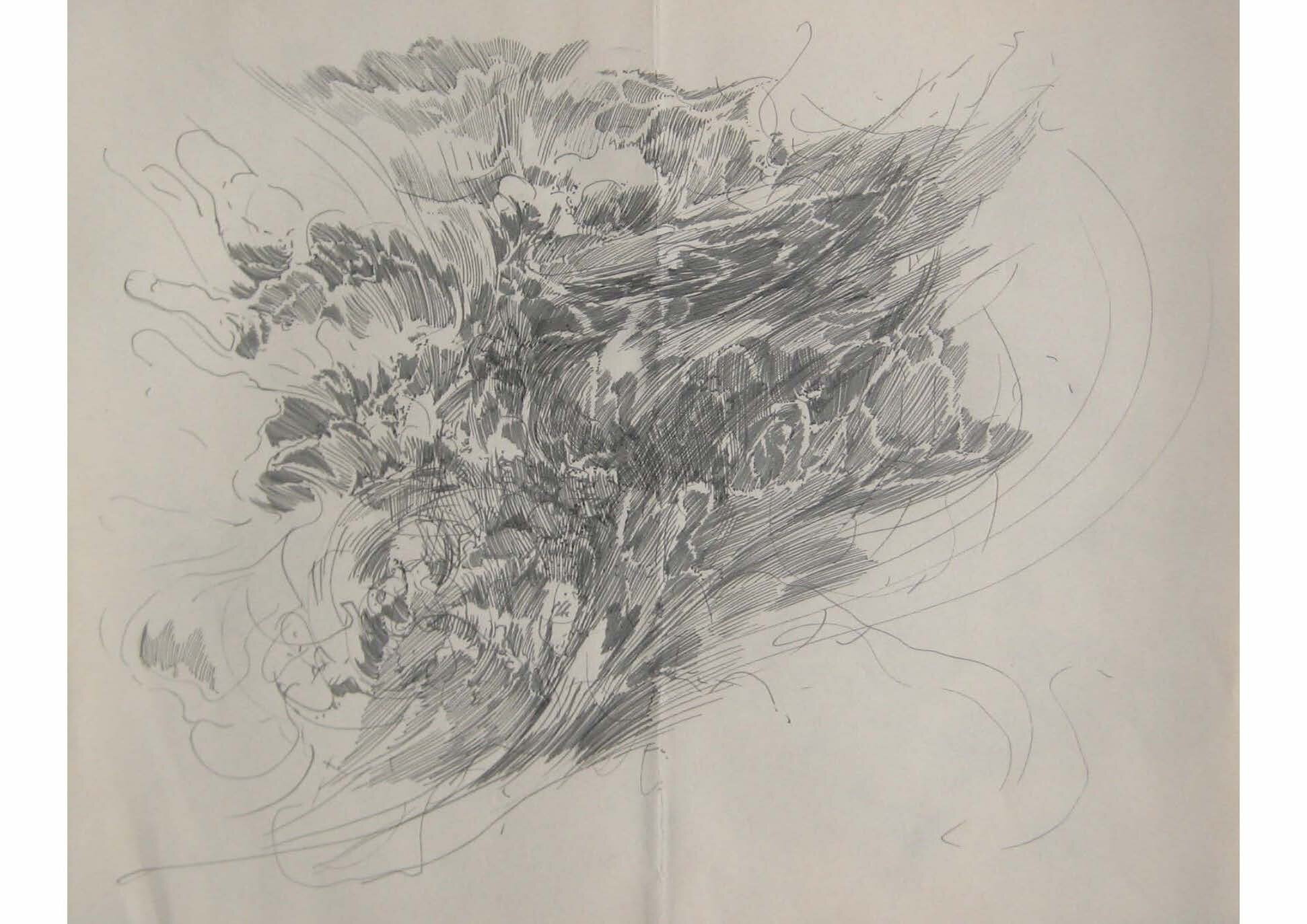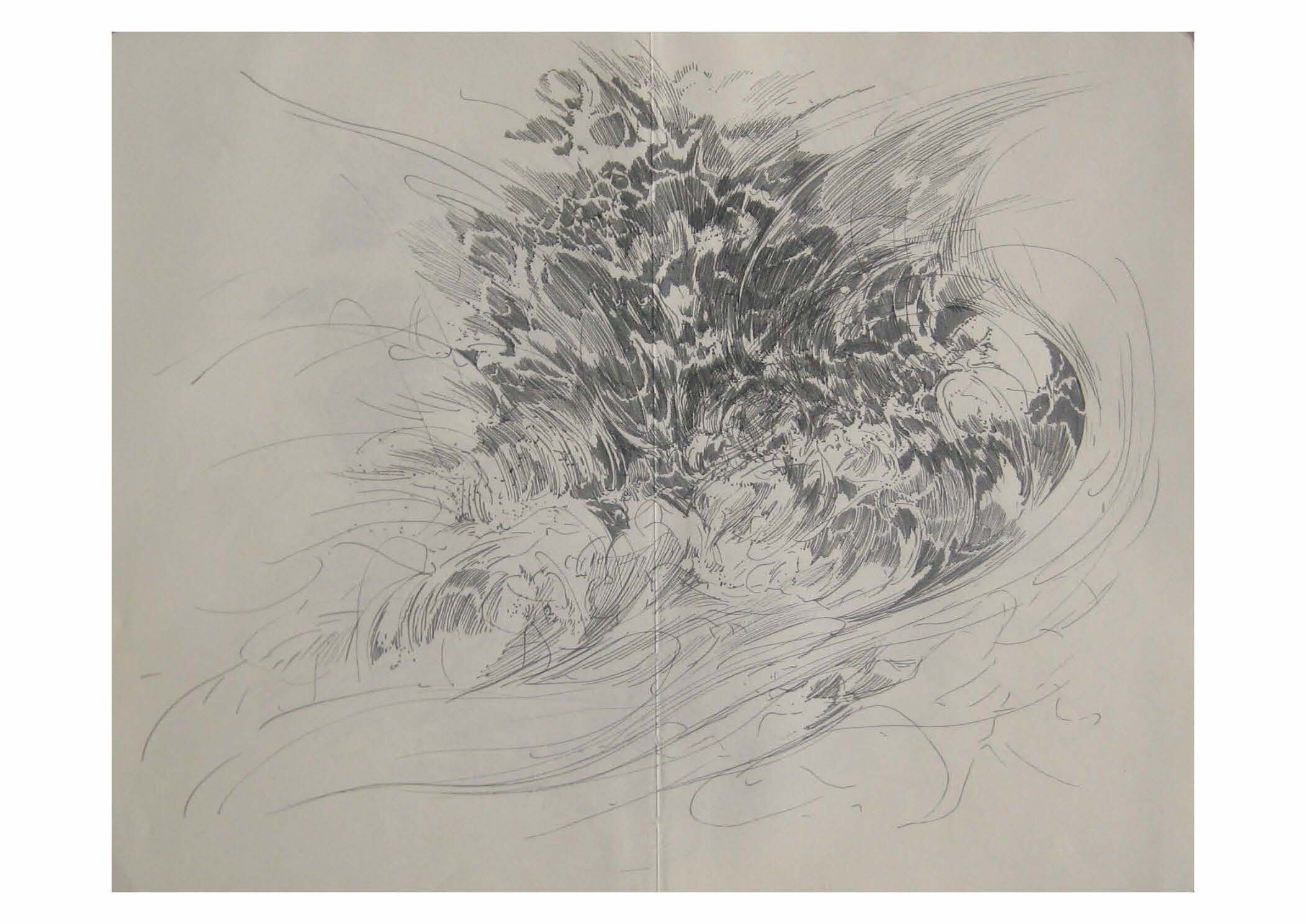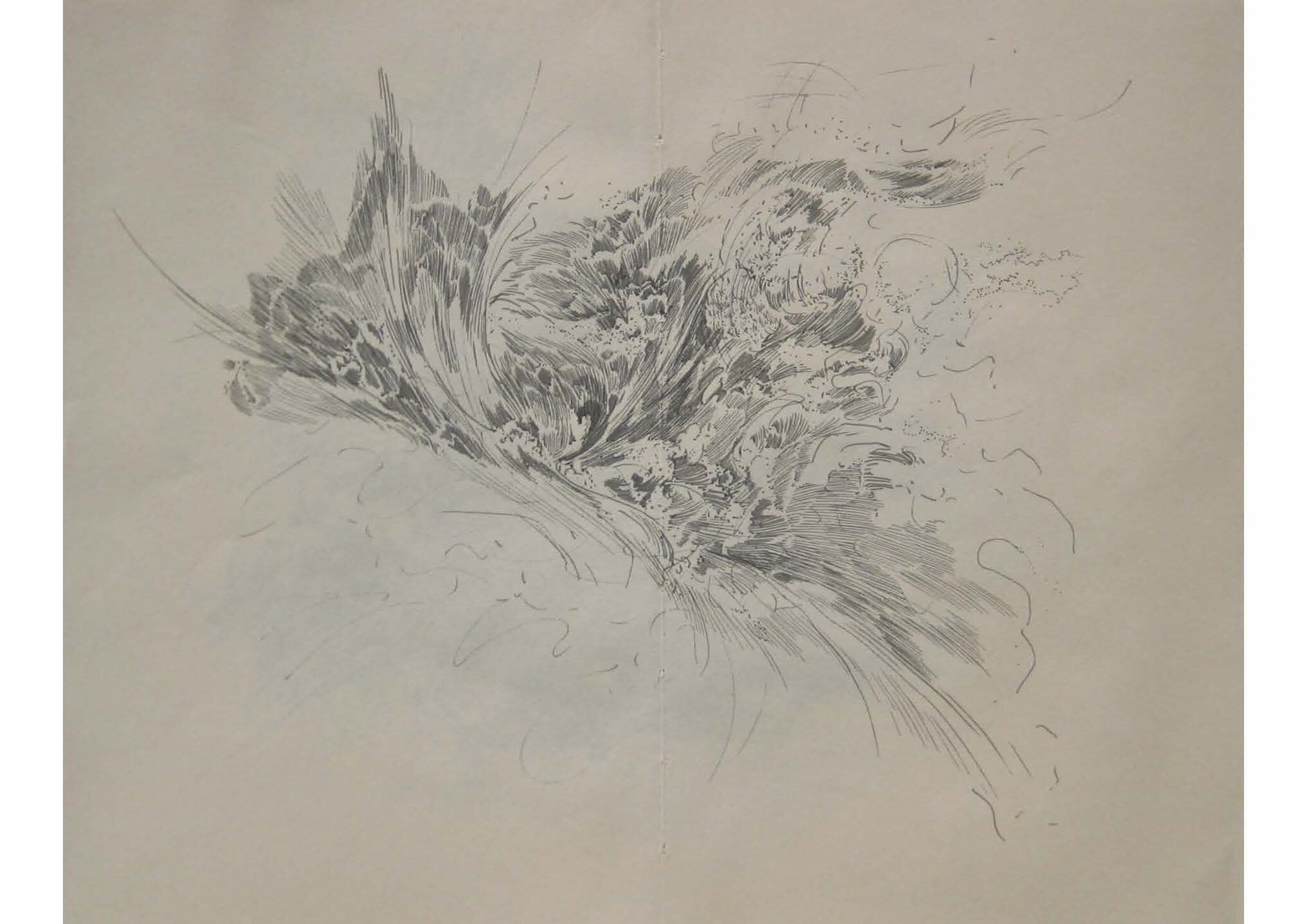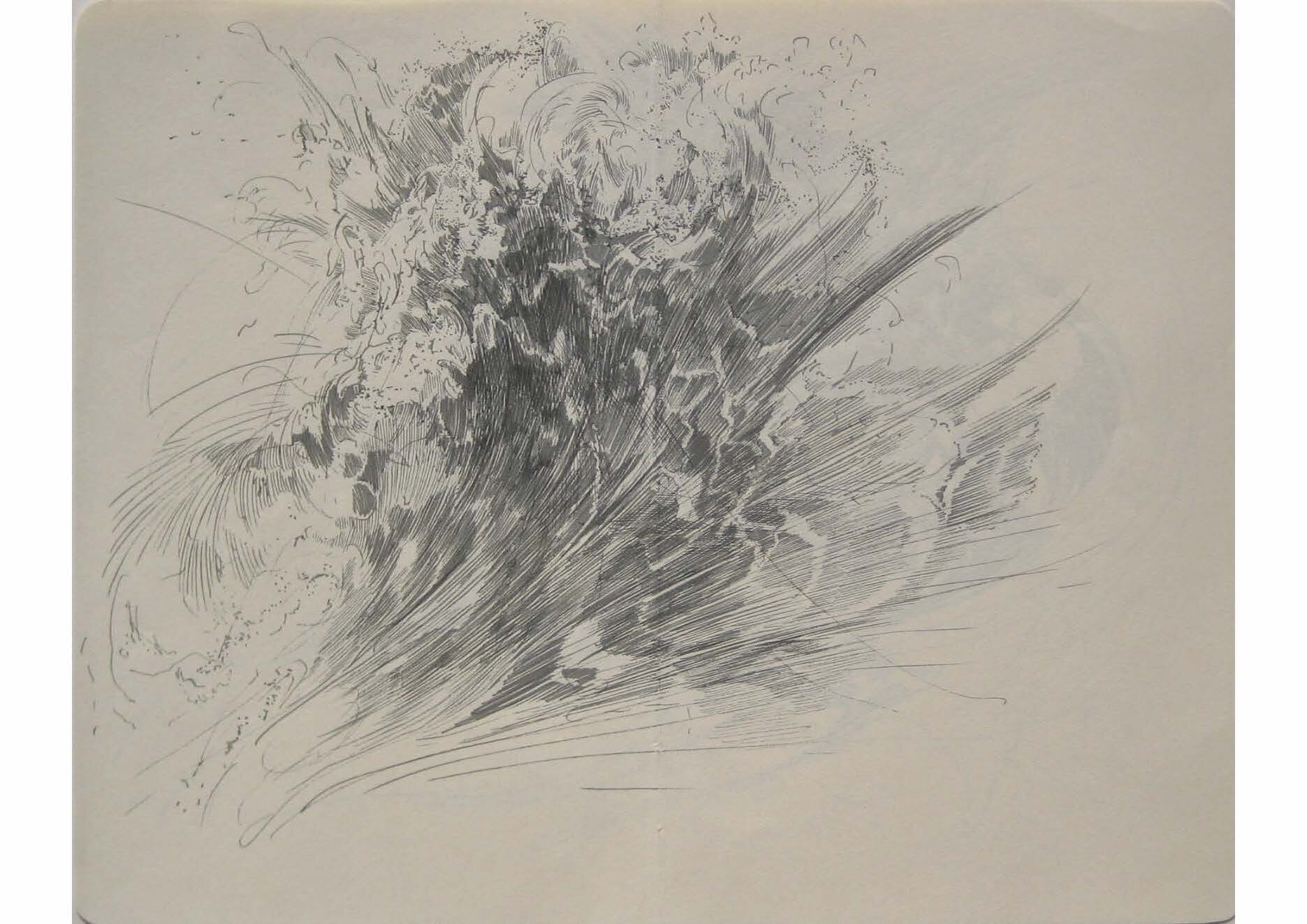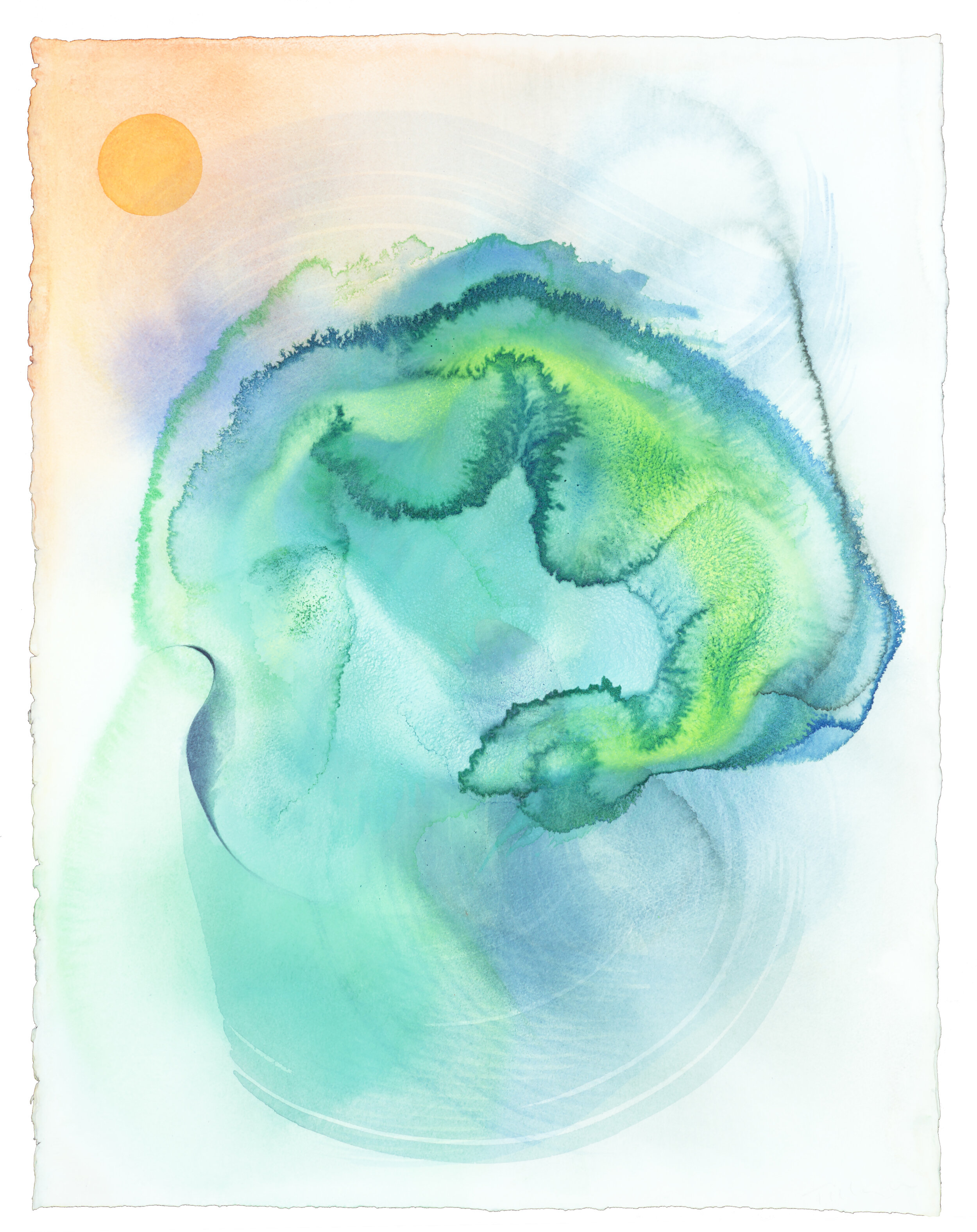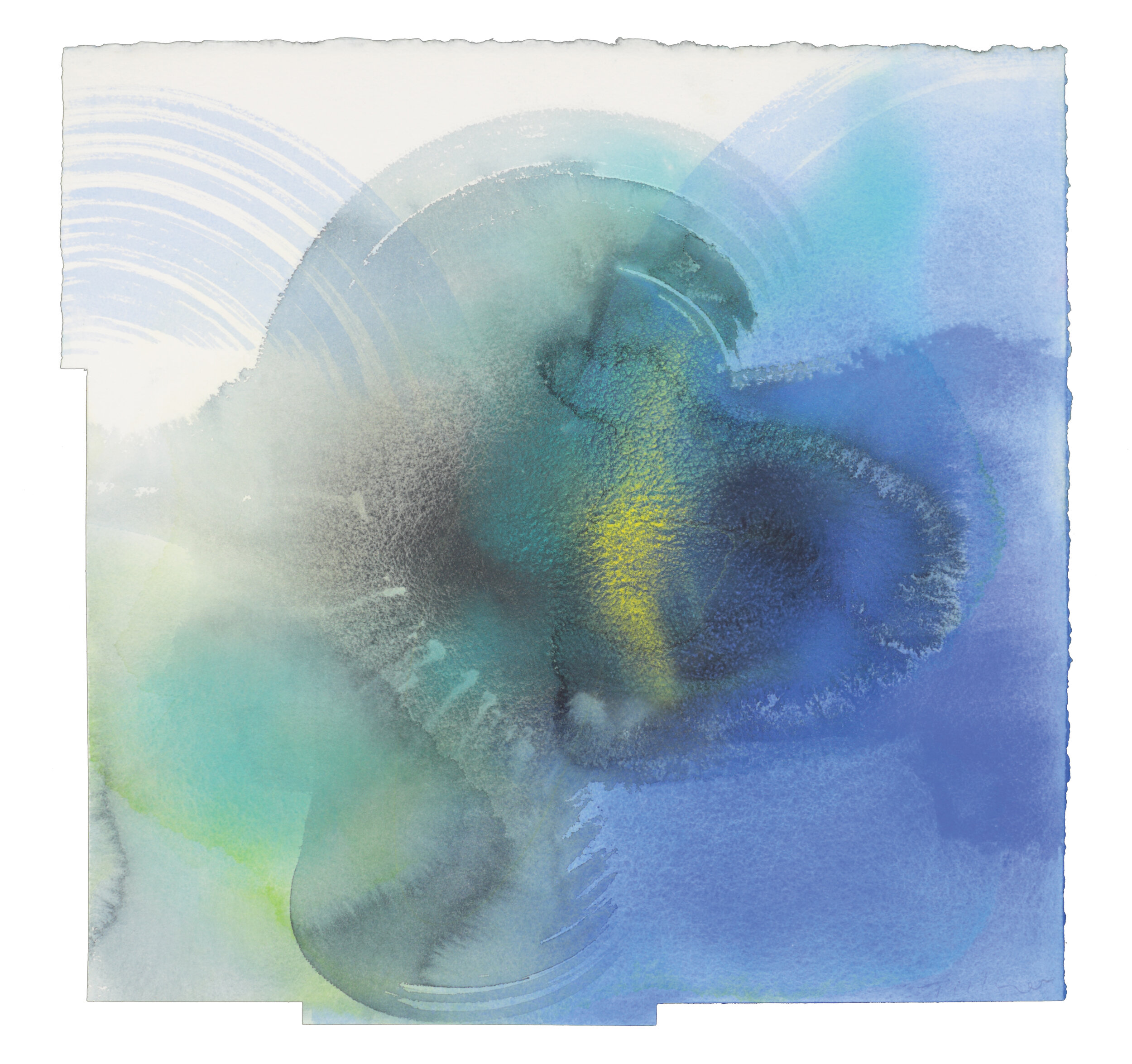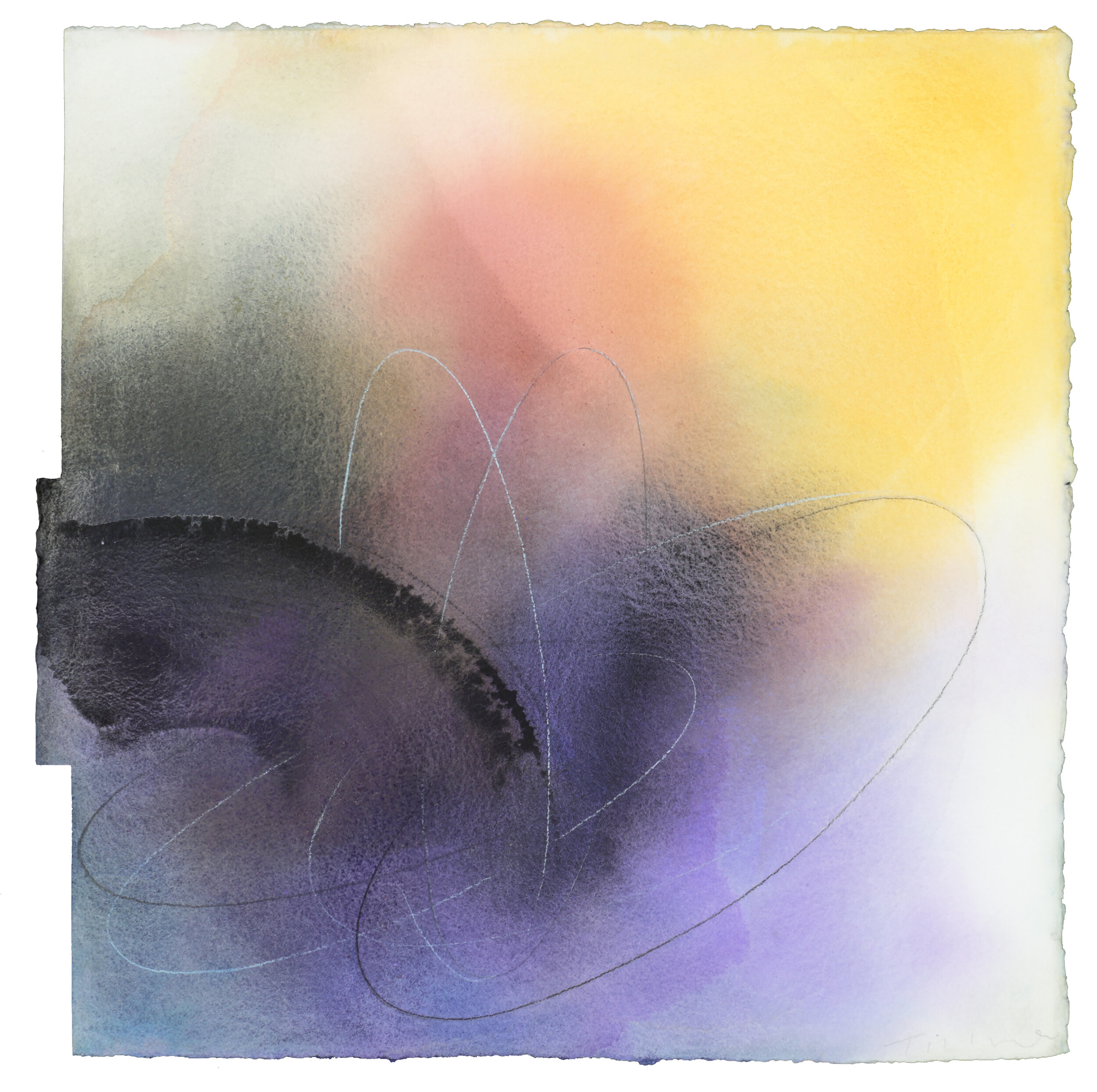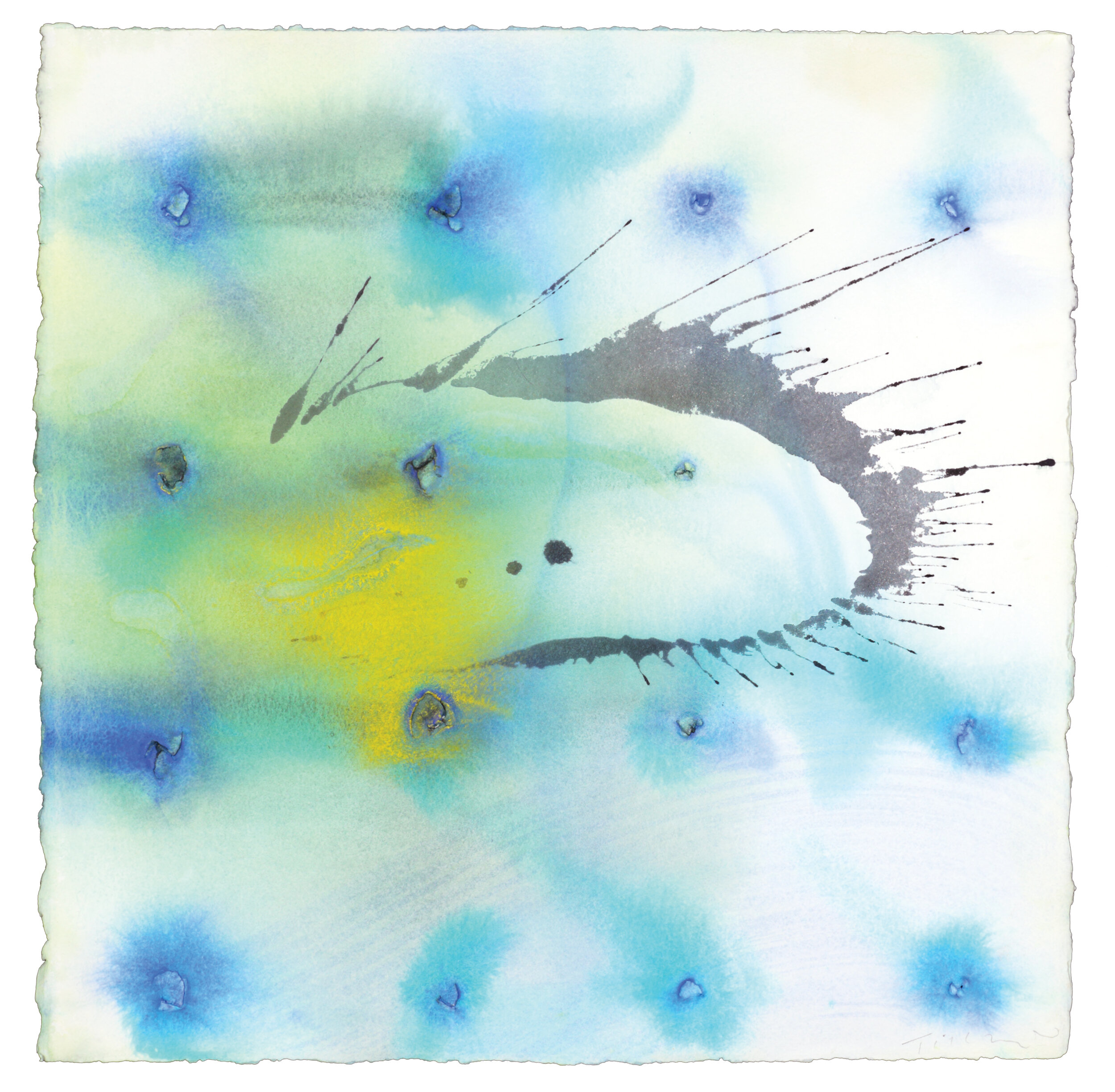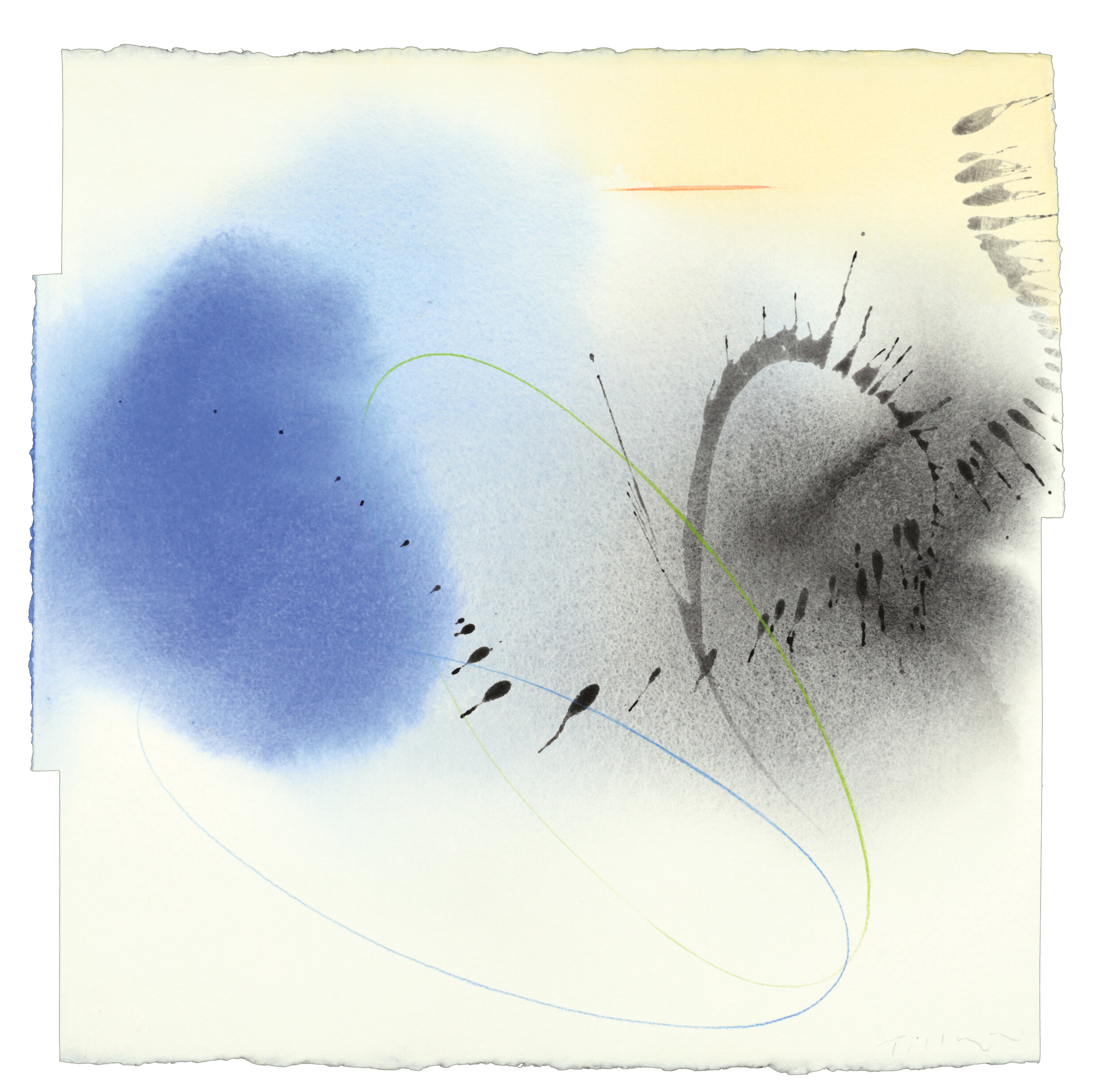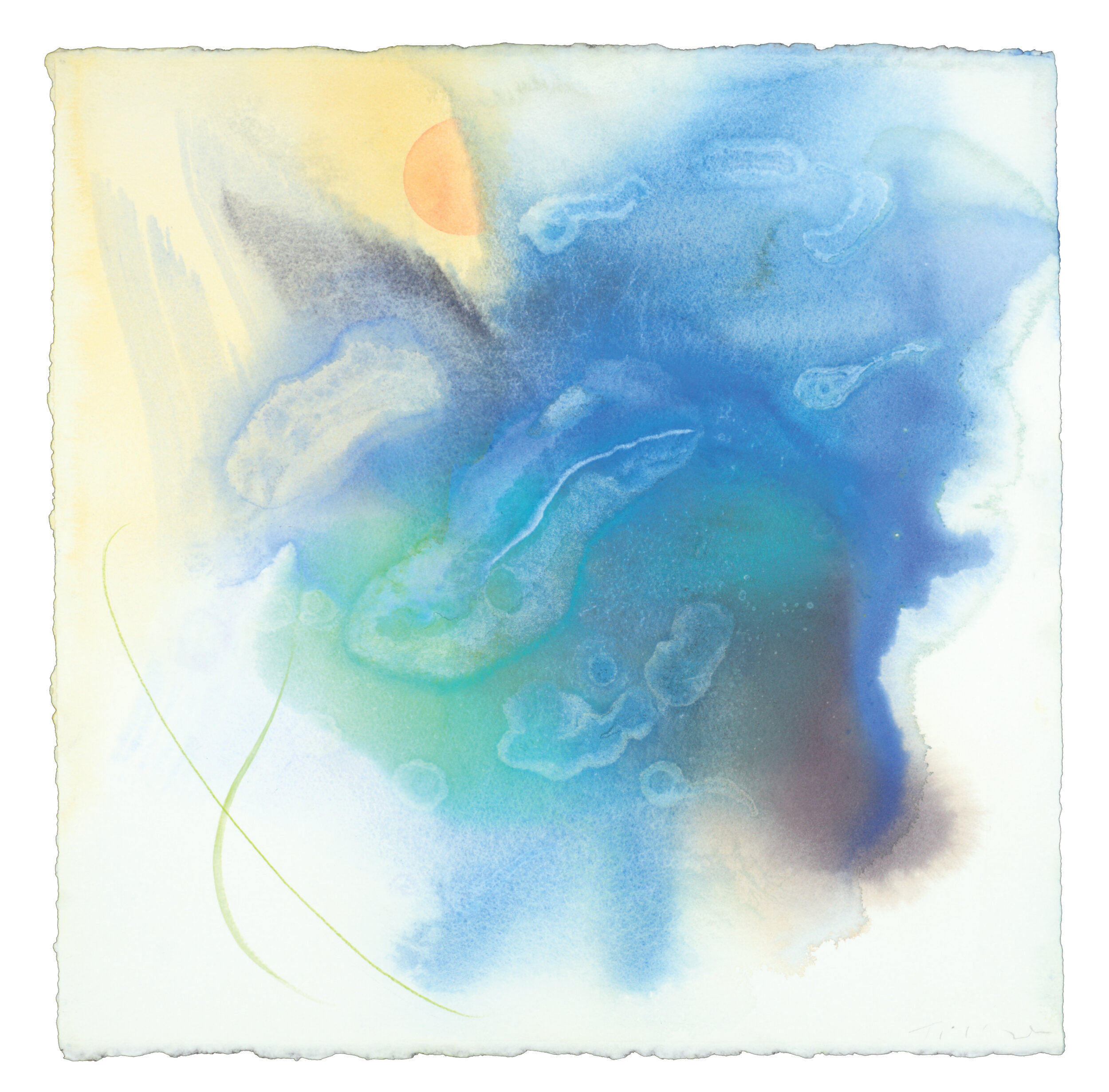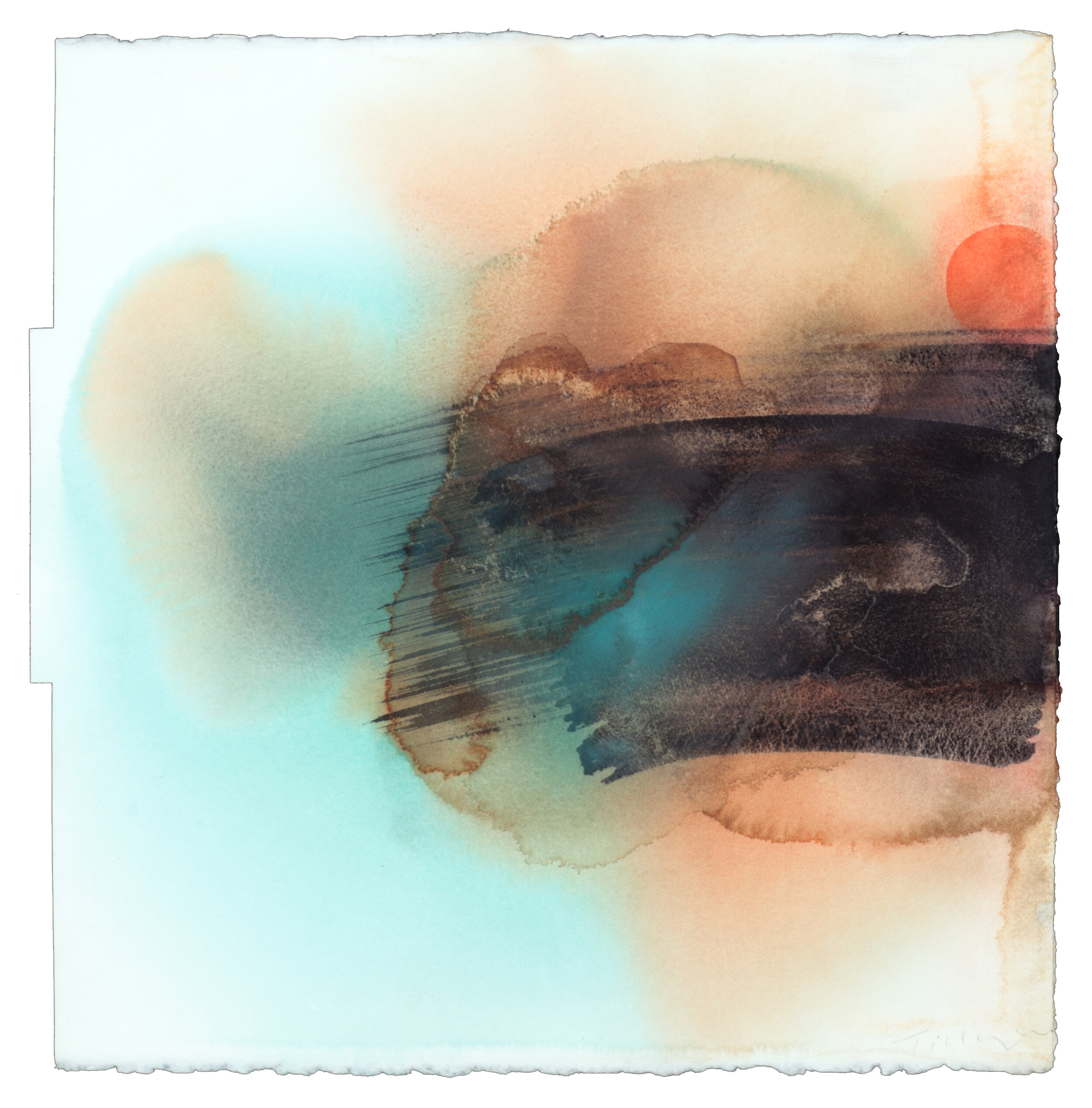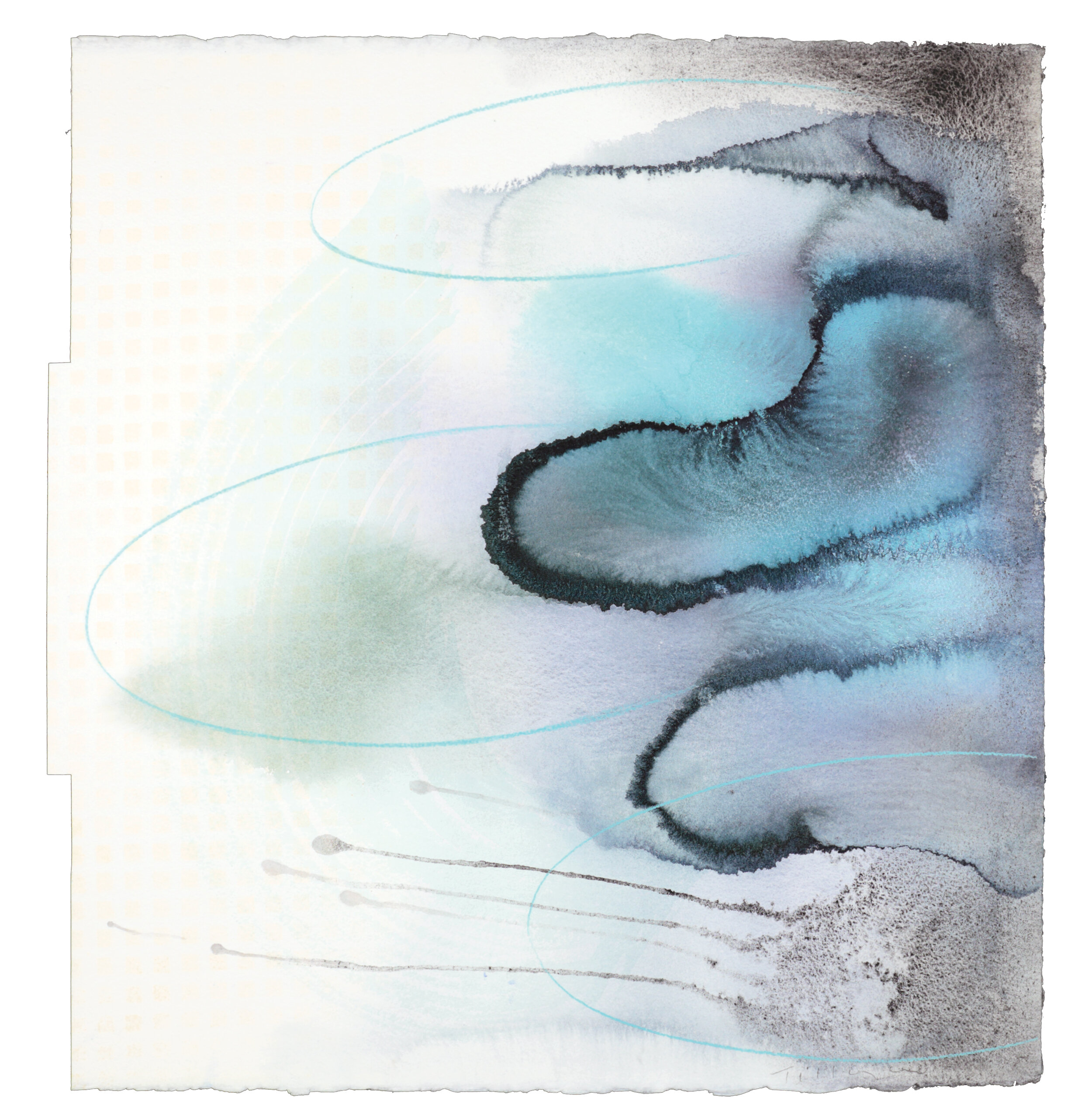essay
The language of between-ness: relocating Alice Oswald
1
In the introductory remarks to her 2020 Oxford poetry lecture on Ted Hughes’ Crow: From the Life and Songs of the Crow (1970), Alice Oswald observes that “the kind of poem I like is not an opinion”. It is a thought - itself an opinion, of course - which calls to mind lines by Roy Fisher, the British poet best known for longer works like City (1961), The Cut Pages (1970) and A Furnace (1986), whose urban landscapes, interconnections with both European and American modernism and a jazz-inflected openness to innovative improvisations might seem to place him somewhat outside the “English mainstream” that Hughes and Oswald have become associated with and feed into. The lines occur towards the end of Fisher’s 1965 poem ‘The Memorial Fountain’ in which he includes a brief self-portrait:
And the scene?
a thirty-five-year-old man,
poet,
by temper, realist,
watching a fountain
and the figures round it
in garish twilight,
working
to distinguish an event
from an opinion [167]
Fisher’s distinction between event and opinion might apply to the act of watching the fountain and the figures round it that occasioned the poem - the effort of a realist to perceive the real rather than what he thinks about the real - but it could equally relate to the idea that the act of writing a poem is both an attempt to distinguish, to render distinct a real-world event, and to create a textual event in and of itself, rather than simply the formation and expression of a preconceived idea. And this seems to embody a very similar distinction to the one Oswald makes when she goes on to contrast the poetry-as-opinion that she doesn’t like with the poetry that she does when she adds that, for her, poetry “is a way of speaking into the silence to see what speaks back”.
In her lecture Oswald’s key examples of what she means by this are drawn from Hughes’ book Crow, but another, quite different British poet, R.F. Langley, also seems to elucidate or even enact a similar approach to perception, speaking and listening. Like Hughes and Oswald, Langley - who was slightly younger than Hughes, but didn’t start publishing the majority of his work until the 1990s - was much concerned with the natural world, but his work too tends to veer away from what might be regarded as conventional ‘nature poetry’ and towards the kind of linguistic and poetic concerns associated with the likes of Roy Fisher (it’s no accident that Fisher included Langley in a personal “poet’s poets’ anthology” he compiled). An ongoing effort towards precision, towards an authenticity of perception (again in opposition to ‘opinion’), characterizes much of his writing - as in the poem ‘To a Nightingale’, which was awarded the Forward Prize for best single poem shortly after Langley died in 2011:
Voices, and some
vibrate with tenderness. I
say none of this for love. It
is anyone’s giff-gaff. It
is anyone’s quelque chose.
No business of mine. Mites
which ramble. Caterpillars which
curl up as question marks. Then
one note, five times, louder each
time, followed after a fraught
pause, by a soft cuckle of
wet pebbles, which I could call
a glottal rattle. I am
empty, stopped at nothing, as
I wait for this song to shoot. [153-4]
Langley had - in the words of his fellow poet J.H. Prynne quoted in the introduction to the Complete Poems - “a lifelong expertise in stillness and quietude” and his “alertness to perception was enhanced by a studied practice of taking up an immobile, silent stance … to open his gaze and thoughts over an extended period, mind busy with interior responses or purposefully blank, to tune into his surroundings” [xiii]. Perception emerges as an event in itself. ‘To a Nightingale’ seems to exemplify the sense of just being there, letting things be in a Heideggerian sense: the poem as a sustained act of tuning into and genuinely hearing the bird’s song, a phenomenon which as Langley notes is ultimately “no business of mine”.
As it happens, Oswald specifically likens poetry to birdsong - that of the blackbird as well as the nightingale - in her lecture on Hughes, noting precisely that combination of phrase and pause that Langley observes and the potentially “fraught” nature of the silence between cadences. This is, she suggests, also how Hughes’ poems in Crow operate: their sonic structures are built around carefully lineated phrasing and the potentially fraught pauses that come at the end of each line. For Oswald, this represents a key element in Hughes’ aesthetic “breakthrough” - a movement away from the “closed lyric” of the early work in The Hawk in the Rain and Lupercal towards the “openness” and “epic” that begins with some of the poems in Wodwo and develops more fully in Crow - as illustrated in the poem she cites, ‘Crow and the Birds’, which begins:
When the eagle soared clear through a drawn distilling of emerald
When the curlew trawled in seadusk through a chime of wineglasses
When the swallow swooped through a woman’s song in a cavern
And the swift flicked through the breath of a violet [507]
Oswald’s own poetry deploys similar techniques and is intensely aware of the blank spaces and the silences that surround her words. Her attentiveness to the relationship between the poem and the open field around it is acute and, when we’re reading her work, ours needs to be too - if we’re going to pick up the sonic layers operating within and across the text. Take, for example, the interplay of line lengths and rhythmic phrases in the opening stanzas of ‘A Rushed Account of the Dew’ from her 2016 collection Falling Awake:
I who can blink
to break the spell of daylight
and what a sliding screen between worlds
is a blink
I who can hear the last three seconds in my head
but the present is beyond me
listen [13]
Or the final poem in that collection, ‘And so he goes on’, which fades almost to nothing on the page:
what is the word for something
fashioned in the quick of hearing
but never quite
but never quite
appearing. [81]
Not that Oswald is averse to using conventional forms (or variations on them) and while much of her work falls into the ‘free verse’ category (which, as she among many others has pointed out, is not ‘free’ at all), there are other notable, more formally structured pieces like the pair of sonnets that make up ‘Two Voices’ - albeit sonnets constructed from rhyming couplets rather than according to a standard Petrarchan or Shakespearean model - and ‘Sunday Ballad’ with its irregular and irregularly rhyming, but still recognisable quatrains.
A questioner called Light appeared,
with probe and beam
began to search the room
where two lay twined in bed
whose intellect surpassing theirs
with no regard
for things half-dressed
accused them of old age [37]
This attention at all levels to elements that are often artificially separated out from content and referred to as structural - a poem’s field (including the blank space or silence that it occupies), form and shape, line and phrase - also contributes to this sense of poem-as- event: it suggests that each poem is emerging into itself as a total poem and that they demonstrate what R.F. Langley calls in a note concerning his own work a “sharpening of their distinctiveness, and the sense of their being separate from each other” [xvii]. It is as if, with every poem, Oswald is starting afresh, from a tabula rasa, rather than merely carrying on with an overall work-in-progress, a project to construct the Oswald oeuvre.
Each of the poems in her 2016 collection Falling Awake, for example, occupies its own poetic space and the poetic space of the long poem ‘Tithonus’ (that makes up the second half of the book) is very different to that of ‘Flies’ or ‘Village’ or ‘Alongside Beans’. Individual poems develop according to their own aesthetic necessities. Much the same is true of her individual collections when considered as a whole: from 1996’s The Thing in the Gap- Stone Stile to 2011’s Memorial, 2002’s long poem Dart to 2019’s Nobody, each book represents, not necessarily a break or breakthrough in terms of its poetic mode or techniques, but a starting over, the beginning of renewed efforts to engage with the world by "speaking into the silence to see what speaks back”.
Oswald’s thoughts on Homer also offer insight into the kind of poetry she sees as being opposite to opinion. She has, of course, responded directly to both The Iliad and The Odyssey in her Homeric ‘excavations’, Memorial and Nobody, and again, for her, what the original performative oral epics seem to embody is the creative inter-relationship between sound and silence. They offer up “each phrase in a silhouette of pause”, as she says in her lecture on Hughes; they evade the closing-in of pure lyric and go “beyond cleverness, beyond annotation”. In Homer, she suggests, there is a stripping away of conceptual thought, of the received and already described - the already finished. Or as Oswald told Max Porter in a 2014 interview published in The White Review: “I’m so in love with what Homer does. He just transmits life. No mediation. He describes a leaf and you don’t get a description of a leaf, you get a proper leaf. That’s always been my principle. You’ve got to make something living, and thinking isn’t living … I don’t feel it with any other poet (beyond flashes of it in, say, Hughes, or Clare or folk poetry), it really does feel as if something - and it’s a lazy word, but - magical has happened.”
What a poet admires or finds magical in another poet’s work or the kind of poetry a poet likes shouldn’t be taken - or mistaken - for a declaration of aesthetic intent or aspiration. No matter how coherent a poet’s conceptualisation and explanation of what the poetry they like is like - the strategies and techniques that they regard as successful, viable or simply aesthetically pleasing and so on - their own decisions during the process of writing a poem are not necessarily determined by that conceptualisation. Ideas about other poets’ work do not constitute a manifesto - and we know from reading the work of poets who do lay out their thoughts in the form of a manifesto that even they don’t necessarily write according to their own prescriptions. Nor should their thoughts about poetry be turned against them when their work doesn’t follow their own rules or replicate the phenomena they have identified as being characteristics of the writing they admire or consider to be great or pure or true poetry. At the same time, however, those thoughts can provide a context for understanding their work and the tensions that provide them with creative energy.
One of the creative tensions that seem to energise Oswald’s work might be identified as the one that exists between the kind of ‘open epic’ work that she admires and a more conventional lyrical approach. A poem like ‘Two Voices’ - from Falling Awake - for example, seems much closer to lyric, despite the unspoken invitation to interpret the two creatures referred to in the poem, the cocky cockerel who claims “I own the dawn!” and the cricket whose creaking sound is “like speaking speeded up”, as in some way allegorical, as figures from folksong or perhaps even Aesop’s fables. Oswald is certainly present as a ‘lyric I’ (whom the cockerel’s cry causes to glance out of the window) and one observation in particular - that the cricket has “painful elbows” - seems to be a rare moment when, by dropping into anthropomorphism, she appears to be offering something that might pass for an opinion or an annotation, rather than the thing-in-itself. The ground shifts again, however, when Oswald brings the poem to a final “letting be … when you duck down suddenly and stare/into the startled stems, there’s nothing there”, and it is perhaps precisely in this shift from the cockerel’s claim on ownership of the dawn via the oddly anthropomorphic “painful elbows” to a kind of phenomenological retreat or “letting be” that this energizing creative tension between poetic modes in Oswald’s work makes itself most visible.
2
That Oswald chose to discuss Hughes’ work in one of her public lectures as Oxford University’s Professor of Poetry is not unexpected. Hughes is one of the poets to whom Oswald’s work is routinely compared. Although Oswald rejects the term ‘nature poet’ (perhaps wisely, given that it is effectively little more than a marketing category), both poets clearly share a deep engagement with the natural world and are alert to undercurrents of myth that attend our understanding of it: how we have constructed - and continue to construct - myths to explain its otherness and our place in it. Both, too, write eloquently of rivers and water, of landscape and weather, and have the landscapes of Devon in common. Oswald’s poem ‘Fox’ can be read as a response to or conversation with Hughes’ ‘The Thought-Fox’, and we might detect the balance of phrase and pause that Oswald finds in the Crow poems in her own work - perhaps most clearly in ‘Various Portents’ from her selected volume Voyager Spacecraft 1, in which cadence and lineation work in a similar way to those of Hughes’ ‘Crow and the Birds’:
Various dazed astronomers dilating their eyes,
Various astronauts setting out into laughterless earthlessness,
Various 5,000-year-old moon maps,
Various blindmen feeling across the heavens in braille.
Various gods making beautiful works in bronze,
Brooches, crowns, triangles, cups and chains,
And all sorts of drystone stars put together without mortar.
Many Wisemen remarking the irregular weather.
There are shared interests too in the classical world and in anthropology and, while both write about the natural world in a determinedly unromantic, unpastoral way, they also both respond to human presences in the landscape through the lives and communities that emerge in, say, Oswald’s Dart or Hughes’ Moortown Diary.
In line with this, it’s also possible to detect similarities with Seamus Heaney - another poet connected with Hughes - and, to a lesser extent, Geoffrey Hill. We might certainly ‘hear’ Heaney (as well as Hughes) in the language and imagery of ‘Body’, Oswald’s response to finding the corpse of a badger:
still with the simple heavy box of his body needing to be lifted
was shuffling away alive
hard at work
with the living shovel of himself
into the lane he dropped
not once looking up [12]
Or of Hill - and perhaps more specifically of his later work - in ‘A Drink from Cranmere Pool’:
Amphibious vagueness
neither pool nor land
under whole velvet
three rivers spring to their tasks
in whose indecent hills
tired of my voice
I followed the advice of water
knelt and put my mouth
to a socket in the grass [28]
We can, in other words, locate Oswald’s work on the literary terrain that extends around some of the pivotal figures in post-WW2 British poetry or, to switch metaphors to a more appropriately watery one, in one of the stronger currents in that poetry. This is not to say that her work is not distinctively her own, that she is following a path already trodden or that she is in some way a neo-Hughesian or neo-Heaneyite. Oswald’s body of work to date is too diverse to be securely slotted into a single current even when that is as broad as the Hughes-Heaney mainstream. As the Irish poet David Wheatley said in a review of Dart published in The Guardian: "Oswald shows that poetry need not choose between Hughesian deep myth and Larkinesque social realism".
The choice that Wheatley suggests here dates back to the infamous introduction to Al Alvarez’s 1962 anthology The New Poetry in which he sets supposedly “genteel” poets associated with the so-called Movement of the 1950s - like Larkin - with more confessional poets that go beyond what Alvarez dubbed “the gentility principle” - like Hughes. This rather simplistic binary division has proved unexpectedly enduring and it is interesting that Wheatley obviously feels he can refer to it forty years later without needing to append much in the way of further explanation. It’s certainly true that Oswald does seem to bridge that particular faultline, but it’s also true that there’s another, perhaps even more significant faultline - a sort of tectonic battleground - that runs through British poetry, one that, in some ways, has proved more divisive than the supposed opposition between “gentility” and “beyond gentility” that Alvarez generated.
This one originates in events that would eventually come to be known as the British ‘poetry wars’ of the 1970s and resulted in a large number of poets, many of them influenced by American modernist poetry, many of them living outside London, being marginalized, sent to the sidelines so that it’s only now - nearly fifty years later - that their work is starting to be given the recognition it deserves. The conflict broke out on the battleground of the Poetry Society’s National Poetry Centre in London’s Earl’s Court and on the pages of the society’s Poetry Review where, for a short while, British poets of the 1960s and 1970s who had picked up on US writers like George Oppen, Charles Olson, Ed Dorn, Frank O’Hara, Allen Ginsberg and Robert Creeley and were associated with what was known as the British Poetry Revival, held sway. Regarded as radicals by more conservative-minded writers, these poets’ arrival at ‘the centre’ of the so-say poetry establishment prompted a reaction that would lead, in the end, to their defeat in the ‘poetry wars’ and result in long-term marginalisation.
By the time Andrew Motion and Blake Morrison published their supposedly generation-defining anthology The Penguin Book of Contemporary British Poetry in 1982, the dominance of those who turned out to be the ‘victors’ in the poetry wars was such that they could casually dismiss the poetry of the previous two decades as uninteresting and omit virtually all the poets associated with the ‘radical’ groupings of the British Poetry Revival. In the introduction to the anthology, in fact, Motion and Morrison go so far as to claim that the “shift in sensibility” they somehow detect in the work of the poets they do include in the book “follows a stretch, occupying much of the 1960s and 70s, when very little – in England at any rate – seemed to be happening, when achievements in British poetry were overshadowed by those in drama and fiction, and when, despite the presence of strong individual writers, there was a lack of overall shape and direction.” Like all such generalisations, this might be most generously described as ‘ill-advised’ - both because there was indeed a great deal happening in poetry, even in England, during the 1960s and 1970s and because the idea that the poetry of any given period might somehow benefit from having an “overall shape and direction” seems debatable. Not unexpectedly, the marketing-manifesto tone of the book’s introduction attracted criticism - Morrison himself reckoned that “nine out of ten reviewers dislike it” - and yet the terrain it laid down, just like that which Alvarez laid down in the early 1960s, continued to dominate British poetry for years afterwards, mostly at the expense of the poets working in relation to other ecosystems who had effectively ‘lost’ the poetry wars.
I mention this here, not simply to indicate that the binary division deployed by David Wheatley isn’t the only one to have been inflicted on contemporary British poetry, but also because the work of the poets who were amongst or associated with those who abruptly found themselves relegated to the margins in the 1970s might also be usefully compared with Oswald’s. Indeed, the three poets I mentioned and quoted from at the beginning of this article - Roy Fisher, R.F. Langley and J.H. Prynne - are all connected, in one way or another with those who were excluded from the Larkin-Hughes mainstreams of British poetry for decades. On the face of it, Oswald’s work differs from theirs in significant ways: I would not imagine that Oswald would describe herself, even half-jokingly, as “by temperament, realist”, as Fisher does; nor does the music of her poetry tend towards the quick-footed sonic shifts in Langley’s work; and nor do her innovations in the use of language extend into the radical disjunctions and semantic jumps of Prynne’s most supposedly ‘difficult’ poems.
At the same time, however, there are points of contact and by extending the field of vision beyond the conventional terrain marked out by Hughes and Homer - and, in Dan Chiasson’s reading of her work, John Clare, Emily Dickinson and Andrew Marwell - we can perhaps gain a richer understanding, not only of Oswald’s relative positioning as a poet amongst other poets, but also of what she does in her work and what her work itself does.
Some of these points of contact I have already mentioned - the favouring of event over opinion; poems as acts of both speaking and listening and as events in themselves; concern with sonic structure as bearer of meaning and not just decoration; interest in the processes of perception, articulation and “letting be”; and, perhaps, above all, the centrality of the line as the fundamental unit of poetry.
In the interview with Max Porter cited above, Oswald specifically makes the connection between how the line-as-unit marks a point of divergence between British and American poetry, saying:
Ashbery always sounds as if he’s thinking, even when you can’t quite get at the thoughts. Jorie Graham uses those expanding and compressing lines, which defeat the eyes and jumble the body’s rhythms so that your mind sort of breaks open. Dickinson actually exposes the pauses in the brain. They all seem to articulate indecision, as if the poem was writing itself in an unfinished moment. I find that quite invigorating.
When Porter presses her to elaborate on why this is different to what she sees as an essentially British approach, Oswald adds:
British poets might put thoughts into their poems, but they pour them in as if the poem is a container and the thought drops in. Something about the American line just incorporates thinking.
Oswald admits that this is a broad generalisation and I would certainly suggest that “British poets” needs a “some” in front of it to allow for those poets, like Fisher, Langley and Prynne (not to mention many others), who, as well as not treating a poem like a “container”, exhibit the influence of “the American line”, chiefly, but not exclusively, via their interest in poets of the Black Mountain and New York schools. At the same time, however, Oswald’s identification of a distinctively “American line” and the fact that she finds it “invigorating” (a feeling that is no doubt connected with her thoughts on the line delivered in her lecture on Hughes) seems to suggest a reading of her work that goes beyond it being a bridge between the twin very English (main)streams of Hughes and Larkin. That work in itself doesn’t constitute a healing of the rift caused by the British habit of turning inwards exemplified by the outcome of the poetry wars of the 1970s and the long-term damage done by Motion and Morrison’s assertions in their 1982 anthology, but the connective tissue that links it with the more so-say radical, so-say avant-garde, so-say difficult poetry of writers marginalised by the metropolitan poetry establishment is certainly a step towards a much-needed opening out into a less restrictive poetic space.
3
There’s a suggestive connection too with another of ‘the overlooked’ among post- war British poets - Basil Bunting. Given his interests and influences, his work can also be considered as a bridge - a bridge between Ezra Pound’s high modernism, George Oppen’s objectivism, Lorine Niedecker’s minimalism and the linguistic innovations of those poets associated with the British Poetry Revival in the 1960s and 1970s. Bunting’s ‘Briggflatts’ is arguably either the last great British modernist poem or the first great late British modernist poem and its publication in 1966 undoubtedly fuelled the American-leaning tendency at the radical end of the British poetry spectrum. Although quite different in style and form, ‘Briggflatts’ - the name of a Quaker meeting house in Cumbria - shares the profound investment in the genius loci of a rural environment that’s also found in Oswald’s Dart. We might hear echoes of these oft-quoted lines from the first section of Bunting’s poem in Oswald’s work too:
A mason times his mallet to a lark’s twitter,
listening while the marble rests,
lays his rule
at a letter’s edge,
fingertips checking,
till the stone spells a name
naming none,
a man abolished.
Painful lark, labouring to rise!
The solemn mallet says:
In the grave’s slot
he lies. We rot. [61]
The undercurrent of death or “whiff of darkness” that Oswald finds in Hughes’ poetry is undoubtedly here, but so too is the connection between words and stone-carving that Oswald has spoken of herself. She has, in fact, described her own poems as “sound carvings” and the idea that poetry is lapidary, analogous to sculpture and stone masonry, is another that courses back through George Oppen to Ezra Pound and, perhaps most specifically, to the writing on sculpture by the British modernist art critic/poet Adrian Stokes. One of Stokes’ core aesthetic principles was the difference between “carving” and “modelling”, the difference being, as he saw it, that a carver enables stone “to flower” - allows the form to blossom from the medium - while a modeller imposes a preconceived idea on the stone. It’s a distinction which appears to echo the one Oswald makes between open epic and closed lyric and the one between the mediated and unmediated in her comments on Homer. It also seems to make a neat fit with her notion of poems being “sound carvings” that she is causing to flower from words.
Indeed, in the same Guardian article in which she’s quoted as saying she now regards her poems as “sound carvings”, Oswald mentions two other processes, connected to stone and carving: erosion and excavation. “I love erosion,” she says. “I like the way that the death of one thing is the beginning of something else.” And a little later adds: “I’m interested in how many layers you can excavate in personality. At the top it’s all quite named. But you go down through the animal and the vegetable and then you get to the mineral. At that level of concentration you can respond to the non-human by half turning into it.” All three of these processes - carving, erosion, excavation - are key elements in Oswald’s aesthetic and they connect her to ways of thinking about art of all kinds that energised modernism and the late modernist developments in poetry written on both sides of the Atlantic after the Second World War.
Here too, perhaps, a connection forms between Oswald and another writer whose work can be thought of in terms of carving, erosion, excavation: Samuel Beckett. Oswald herself has said she finds him “interesting” - “a pinhole writer: he created a darkroom of language through which, despite himself, light passes”, a description which, in some ways, might be applied to those parts of her own work that concern erosion - as a natural process as well as an aesthetic principle - and “the death of one thing [being] the beginning of something else”.
As others have pointed out, the precision timing built into Oswald’s long poem - or performance - ‘Tithonus’ and even the layout of the text in the printed version recall Beckett’s scrupulously detailed structures and instructions in plays like Footfalls or Rockaby. Yet there are echoes of Beckett elsewhere in Oswald’s poetry too. ‘Dunt: A Poem for a Dried-up River’, for example, has a thoroughly Beckettian atmosphere, conjuring, as it does, an arid, eroded, “exhausted utterly worn down” riverbed and the “little shuffling sound as of a nearly dried-up woman” (the “dry grass” repeatedly mentioned in the poem suggests Eliot too). The repetition of phrases and images is similar to Beckett’s patterned texts while the voice that cuts into ‘Dunt’ - either the ‘voice’ of the poem turning on itself or another voice cutting across it - with its increasingly insistent “try again”s and “go on”s, sounds very much like one of the contrapuntal imperative voices in Beckett’s work and perhaps directly alludes to one of his most well- known ‘instructions’ from Worstword Ho: “Ever tried. Ever failed. No matter. Try again. Fail again. Fail better.”
In Oswald’s ‘Village’ too the voice - or voices - of the poem repeats itself, as if trying to secure some kind of reassurance, fragmenting, chopping and changing direction and generating the kind of nervy anxiety found in much of Beckett’s prose:
somebody out thankfully not me out lost in the mud
somebody lost out late again say what you like
a boot by the granite trough not many of us left
living in the slippery maybe the last green places are you listening
not many of us left not much movement
in the blackening lanes among a few low trees
little flocks of orchids in the ditches nobody cares
it’s as dark as a pond down here we could do with a hedge-flail
with a scythe somebody with a scythe
you can hear him smashing through six-foot nettles
black jumble-sale clothes with a bit of string round the knees
so the rats won’t run up his legs are you listening [18]
That repeated “are you listening” or the relief in “thankfully not me out” seem particularly reminiscent of Beckett, not in the sense that these exact phrases are ones you might imagine Beckett using (although you might well do so), but because of the way Oswald deploys them. They cut across the run of the rhythm, just as a mind does interrupt itself and the self can require reassurance that it is “not me out” and that it is being listened to, making contact with and communicating with another.
This same tone carries over into ‘Tithonus’. Lasting precisely 46 minutes, Oswald’s poem-performance is built on the myth of the man who, at the dawn’s request, is granted immortality by Zeus. The dawn, however, neglects to ask that Tithonus - with whom she has fallen in love - also be prevented from aging and so he grows older and older until, as Oswald explains in her introduction to the piece, “at last the dawn locked him in a room where he still sits babbling to himself and waiting night after night for her appearance”. Again this is a predicament that we might recognise from Beckett - the self trapped in an unbearable situation that it somehow manages to endure: what we might call Beckett’s “I can’t go on. I must go on” paradox (from the ending of his 1953 novel The Unnamable). Beckett, in fact, identifies such a paradox with the creative process itself, telling the French writer Georges Duthuit: “The expression that there is nothing to express, nothing with which to express, nothing from which to express, no power to express, no desire to express, together with the obligation to express.” [Calder,15]
This version of the Beckettian paradox may also enable a reading of Oswald’s ‘Tithonus’ as a sort of meta-poem: it is not only a meditation on the human predicament in relation to time and mortality, but also a dramatization of the quandaries of the creative process itself. Early on in the piece, for example, Oswald writes:
as soon as a voice goes on arguing
in its sleep like a file going to and
corrosively fro
doesn’t like a man sounds
more like an instrument’s voice very
small
so the thought goes on recycling
itself and the mouth opens and the
body begins to shrivel into some-
thing more portable
which is me old unfinished not
yet gone here I go again
The last line in particular seems to enact the same predicament as Beckett describes when he talks about there being nothing to express, but still feeling the obligation to do so - “yet gone here I go again”. And yet, like Beckett too, Oswald doesn’t leave us only with the fragmentary broken thoughts of someone caught in a seemingly impossible quandary: just as Beckett leaves some hope, no matter how miniscule, for even his most beleaguered characters to survive on, Oswald’s ‘Tithonus’ also brings us images of awakening, of the natural world arriving into sound and light, the dawn chorus, “a small field sliding at the/speed of light straight through the/house and on to the surface of the/eye” and - finally - the sun that “saws the morning into beams”.
4
To draw out these connections with poets and writers from Homer to Hughes, Beckett to Bunting, Langley and those others that I have referred to as the overlooked of the British Poetry Revival in the 1960s-70s is not to reverse the generally held opinion that she ‘belongs’ in the Hughes-Larkin ‘mainstream’ or to suggest that she is becoming a fashionable post-modernist meta-textual collagist. Rather it is simply an attempt to map connections, similarities, overlaps, shared concerns, and consequently to expand the description of the literary and aesthetic terrains across which Oswald’s work travels. From the thematic and linguistic reach of Dart to the “wind-blown, water-damaged” voice of Nobody (as she herself describes it in that book-poem’s introduction), from the tripping couplets of ‘Two Voices’ and ‘A Short Story of Falling’ to the Crow-like “open” lines of ‘Various Portents’ and the brittle anxieties of ‘Village’ and ‘Tithonus’, these terrains are many and varied - perhaps unusually so in an age when poets are expected to find a voice (with which to construct a marketable career) and when early thematic tendencies can carry the risk of a poet becoming locked into a model of specific expectations: once a nature poet, always a nature poet, once a Hughesian, always a Hughesian, and so on.
Oswald certainly hasn’t allowed herself to become locked in in that way. She has a distinctive voice, of course, but it has many different registers and tones. Each poem is “entire of itself” (as John Donne might have it) and each one’s specific form, lineation, syntax, sonic structure etc seems uniquely carved or excavated for and as fundamental and inextricable parts of itself. To summarise, paraphrase or reconfigure an Oswald poem would be not only pointless, but impossible. It would be to ignore their existence as poems-as-event - open fields of contrapuntal sound and silence - and reduce them to opinion or lifeless thought.
Perhaps, above all, what Oswald’s work offers is an extension of the idea that she voices in her lecture on Hughes - one which takes David Wheatley’s assertion that Dart shows us that “poetry does not need to choose between Hughesian deep myth and Larkinesque social realism” a little further and suggests that poetry itself needn’t make any and/or choices at all:
Poetry is the language of between-ness. Poetry needs to be neither one thing nor another. The lyric must have epic stitched into it. And epic must have patches of tragedy and tragedy needs to break into lyric and sometimes fall face forwards into comedy.
Or perhaps this other thought, which seems to echo the approach manifested in and behind the work of many of the British late modernists, the ones who aren’t Ted Hughes or Seamus Heaney, taken from Oswald’s interview with Claire Armistead in The Guardian:
Poetry is not about language but about what happens when language gets impossible.
Works Cited
Alvarez, Al (ed.). The New Poetry. Penguin Books, 1962.
Bunting, Basil. Complete Poems. Bloodaxe, 2000.
Calder, John (ed.). A Samuel Beckett Reader. New English Library, 1967.
Fisher, Roy. The Long and the Short of It. Bloodaxe, 2005.
Hughes, Ted. Collected Poems. Faber and Faber, 2005.
Langley, R.F.. Complete Poems. Carcanet, 2015.
Motion, Andrew & Morrison, Blake (eds.). The Penguin Book of Contemporary British Poetry. Penguin Books, 1982.
Oswald, Alice. Falling Awake. W.W. Norton & Company, 2016.
Oswald, Alice. Spacecraft Voyager 1. Graywolf Press, 2007.
Schmidt, Michael (ed.). Some Contemporary Poets of Britain and Ireland. Carcanet, 1983.
Articles, reviews etc
Armistead, Claire. ‘Interview with Alice Oswald’, The Guardian, 22 July 2016. Available online: www.theguardian.com/books/2016/jul/22/alice-oswald- interview-falling-awake
Chiasson, Dan. ‘Alice Oswald’s Falling Awake’, The New Yorker, 5 September 2016. Available online: www.newyorker.com/magazine/2016/09/12/alice- oswalds-falling-awake
Morrison, Blake. ‘Or am I being paranoid?’. Poetry Review, January 1984. Available online: http://poetrymagazines.org.uk/magazine/recordfd11.html?id=29885
Oswald, Alice. Lines Oxford poetry lecture, 12 November 2020. Available online: www.youtube.com/watch?v=UvqcHX37s2Q
Porter, Max. ‘Interview with Alice Oswald’, The White Review, August 2014. Available online: www.thewhitereview.org/feature/interview-with-alice-oswald/
Prynne, J.H.. ‘Difficulties in the Translation of “Difficult” Poems’, Cambridge Literary Review 1/3, Easter 2010.
Wheatley, David. ‘This is Proteus, whoever that is’, The Guardian, 13 July 2002. Available online: www.theguardian.com/books/2002/jul/13/featuresreviews.guardianreview13


